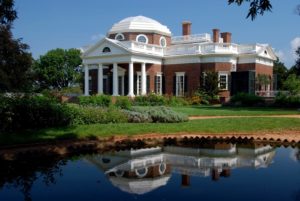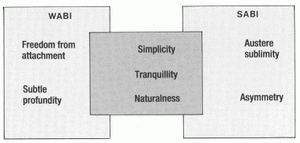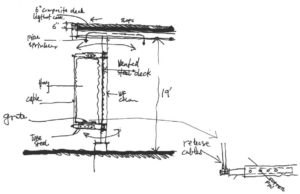
Somis Hay Barn
Although a small component of a sprawling ranch on 40 acres of hills and citrus groves, the Somis Hay Barn has become one of our most widely-published designs. Envisioned as a more thoughtful interpretation of a structure typically thought of as utilitarian and mundane, we infused our hay barn with beauty and wonder by choosing a unique exterior cladding: the hay itself.
Additional Credits: John Linden (photography)
The Sharpe Residence
SPF:a founder and design principal Zoltan Pali was first approached by client Steve Sharpe in 1987 to design a SoCal country estate in Somis—a small agricultural community in rural Ventura County, about an hour outside LA—but the economic downturn of the late ‘80s delayed the planning phase of what would become the Sharpe Residence for well over a decade.

One of Zoltan’s earliest independent commissions, the home’s style changed considerably over the course of the project’s many delays; originally envisioned as a more traditional neoclassical estate (think Monticello : ornamentation and grandeur like Greek columns, arched doorways, and elaborate, formal interiors), the final aesthetic of the 10,000-square foot L-shaped Sharpe Residence is more modern and minimalist, with no unnecessary flourishes and an exceedingly open interior layout.
: ornamentation and grandeur like Greek columns, arched doorways, and elaborate, formal interiors), the final aesthetic of the 10,000-square foot L-shaped Sharpe Residence is more modern and minimalist, with no unnecessary flourishes and an exceedingly open interior layout.
An expansive 40-acre site full of hills and citrus groves, beyond the main home the scope of our work included various master planning and supporting ancillary components—most notably a hay barn to store and feed the client's horses.
Modernism & Wabi-Sabi
In rethinking the traditional hay barn, we explored a creative and poetic way to satisfy the practical requirements. Ultimately we were guided by two contrasting principles: the rhythmic rigor and permanence of Modernism, and the rough, ever-changing quality of wabi-sabi, a Japanese aesthetic that finds beauty in imperfection.
We expressed Modernism's order in the choice of a sleek 12-by-12 foot structural steel system, elevating and underscoring the barn’s precise geometry while maintaining its functional simplicity. Much like Sharpe’s main residence—which is similarly organized around a strict grid, inspired by the site’s patterned rows of fruit trees1—the Somis Hay Barn is an old-school structure molded by utility and reworked to its essence.

The ephemeral nature of wabi-sabi is seen in our choice of the hay barn's cladding: the hay itself. The hay, when stacked along the outer storage shelves in the winter, is green, but as the season unfolds turns yellow, announcing that it is time to remove it from the shelves and use it for feed. The façade is forever in a state of evolution, and we imagine our humble barn to be a metaphor for life, death and birth: common seasonal themes in an agrarian society.
Wood & Steel
We conceived the steel and cedar-wood frame as a grid system with large shelves supporting the stacked bales of hay, forming a well-ventilated and insulated wall. A metal roof deck extends well beyond the barn's edges, protecting the interior and stacked bales of hay from the rain. We originally designed movable cables to hold the bales in place, but this proved unnecessary, as the friction created by the hay does the job just fine.
with large shelves supporting the stacked bales of hay, forming a well-ventilated and insulated wall. A metal roof deck extends well beyond the barn's edges, protecting the interior and stacked bales of hay from the rain. We originally designed movable cables to hold the bales in place, but this proved unnecessary, as the friction created by the hay does the job just fine.
Client concerns led to two additional changes from our earlier designs: initially, we had planned for the exterior to be made out of perforated metal and to leave the space below the shelf exposed. Our rationale for each choice was to further emphasize the impression that the stacked hay was simply floating on air, as opposed to being merely ‘stacked’. The client, however, felt that the perforated metal was too much of a departure from the traditional barn structure, and was worried that an open space below the shelf would endanger the horses. We addressed these changes by swapping the perforated metal with the cedar-wood siding and extending the façade below the shelf all the way to the ground.
The barn has the capacity to house four horses while also providing space for tractors and all the other farm equipment necessary to maintain the ranch's forty-acre lemon grove. Our steel structural system is constructed to the ideal dimensions for a horse stable. We encouraged natural ventilation through open clerestories and installed a breezeway separating the horse stalls from the client's storage areas and office.
Reflection & Praise
After nearly two decades, work on Sharpe's estate was completed in 2005. In 2008 The LA Times featured the site in an article titled The Ranch, Refined, writing that it is "a design that presents an alternative picture of what country life can be." Lauded for his modern take on a traditional archetype, in the same piece Zoltan was quick to clarify what that meant to him. "One can make the assessment that its 'style' is modern, and that it is odd to see it in a rural setting. This is true. But Modernism is not a style but rather a way of living. I know that recently Modernism has become a style, and that frightens me. The over 'coolification' of everything is turning Modernism into a style and sort of a commodity—something that it should not be. It should remain in the high road, intellectual and philosophical."
Admired for its poetic interpretation of a simple and often ignored structure, the Somis Hay Barn has received many accolades, including the prestigious AIA National Honor Award for Architecture in 2004. One of 13 projects selected from over 400 entries, the jury described the barn as "visually quiet with a simplicity of form with a constantly changing exterior. The barn is in harmony with its surroundings as well as the creatures that inhabit it."
One of our first forays into what has become a common marriage of strict modernist principles with an abstract meditative ethos, we are proud of our barn’s warm reception, but also a little flummoxed: it is, after all, just a hay barn.
The barn is in harmony with its surroundings as well as the creatures that inhabit it.| AIA National Honor Award Jury
Notes
-
1
The trees are regimentally spaced 14 feet apart, and we laid out the Sharpe Residence on a similar grid, placing the walls and stucco screed lines 7 feet apart and the windows and doors 3½.
Awards
- AIA California Council Award 2005
- AIA|LA Design Merit Award 2004
- National AIA Honor Award 2004
- Los Angeles Business Council Award 2003
- AFLA Design Recognition Award 1999
- PA Citation, Architecture Magazine 1999
Publications
- From Shiny to Rusty: 10 Impressive Examples of Metal in Architecture - Archinect 2018
- Rural Design: A New Design Discipline 2012
- Inspired by Nature: Plants: The Building/Botany Connection 2008
- The Ranch, Refined - LA Times 2008
- LA 2000+: New Architecture in Los Angeles 2006
- A Measure of Time - Metropolis 2005


















